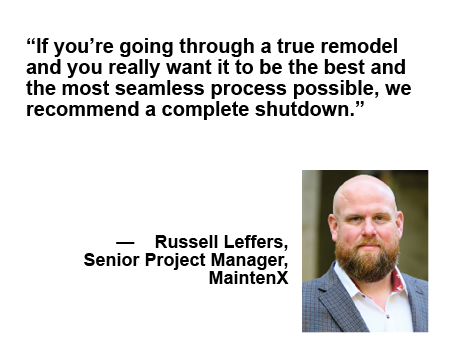It’s going to happen, and any quick-service restaurant (QSR) owner-operator knows it. Sometime not too far in the future, they’ll need a refresh or remodel of their properties. There’s no getting out of it.
Here are some hints from two project managers from MaintenX, a provider of HVAC&R, plumbing, electrical, roofing, construction and general contracting for multisite retailers, restaurants, healthcare, multifamily and other industries. They cover key topics like assembling the correct refresh or remodel team, managing the process and keeping projects on track in the face of potential delays, with a focus on special QSR-specific considerations.
Remodel Versus Refresh
Every chain and franchisor has its own scheduling for changes. “A refresh is intended to make a location look new again — maybe replacing carpeting or ceiling tiles, touching up fixtures, swapping out furniture and taking other steps to keep a place from looking tired,” says senior project manager Russell Leffers. That needs to happen about every five years.
A remodel is more extensive, and it can involve “taking a building down to studs and exposed electrical, changing lighting, reworking the floor plan, updating the food service line or refrigeration systems, repurposing an underutilized area and adding more seating, parking or a food delivery pickup,” Leffers explains. These changes are on a roughly 10-year cycle and are far more extensive and expensive.
Set the Countdown Clock and Get the Team Ready
Start the process ahead of when the work has to be done. First, check the lease on the property. Know who is responsible for what costs. Do advanced work on the relationship with the landlord or franchise to help avoid any delays and to set expectations.
Before work begins, bring experts in for some analysis. QSR chains or smaller owner-operators will typically have a design or prototype of what needs to be done. “They will then ask us to look over the design and point out any functional or practical issues that might negatively affect any aspect of construction,” Leffers says. Work with your general contractor to catch problems before they throw off any timelines.
A large operation will have architects and engineers they regularly work with. A single operation or small chain will need to find both types of these professionals to ensure work will be designed appropriately and up to local building codes. Contractors should handle the necessary permitting and check if there are specialty areas, such as fire suppression, plumbing or HVAC, that will need a trade permit. Trade permits are more likely to be needed in a remodel than in a refresh.
Manage the Process and the Ongoing Business
A refresh requires a smaller amount of work. Experienced construction crews can generally complete the project in as little as a few days. A remodel is more in depth and is the perfect time to take care of both accumulated problems and new opportunities for long-term greater efficiency and energy savings. That process can take as long as a full month.

MaintenX
Locations can often remain in operation during a refresh by sectioning off parts of the building under work. In these cases, it is important to consider how to keep customer bathrooms and parking spaces available while work is done, explains Roberto Pajon, a MaintenX project manager. Working with an experienced contractor can help identify the necessary considerations and make the process run much smoother.
In contrast, normal operations are unlikely during a full remodel. “If you’re going through a true remodel and you really want it to be the best and the most seamless process possible, we recommend a complete shutdown,” Leffers says. Otherwise, contractors will likely need to use overnight crews and plan around operating hours and needs, which can get expensive and cause delays.
The bright side of a complete QSR shutdown is easier risk management. During the typical 10-year cycle between remodels, owners and operators become aware of issues with pipes, tiles, roofs, parking lots and other interior and exterior aspects of a property. “Rather than waiting for something to go wrong, taking the build down to the bare bones is a good way to maintain the store,” Pajon says. The more that contractors can identify and rectify during a full remodel, the greater potential savings the location owners and operators can realize by avoiding an unexpected and unscheduled long closure.
A full remodel is also a time to update systems like dishwashers, fryers, grills, exhaust hoods and more. The changeovers can speed production while reducing energy and water use.
“The new technology is so good, it can give big boosts to efficiency,” Leffers says. “Some of the new equipment also has the advantage of being more compact, with less electrical draw. In some cases, a restaurant can replace one piece of equipment with two newer units, making the location more productive and the workflow easier. Often, retrofitting old equipment can also be healthier for workers and customers.”
Financial Analysis and Avoiding Delays
Financial analysis during the advanced stages of project planning can help keep expectations realistic. Track how much life is left in existing equipment, the cost of the new or likely energy savings and the amortization of it all to understand the impact on finances.
Finally, be sure to pick a contractor that is highly experienced with refresh and remodel dynamics. “At MaintenX, when we have a start date for a job, we order all our materials and store them on site,” says Leffers. “That way, when teams or vendors come to install something, the units will be available and we can avoid delays. We communicate with everybody going forward and stagger all of our trades. If our tile guy finishes work sooner, our plumber can move in to set up toilets and sinks. There’s always something going on so that everything gets done as quickly as possible.” Experience means that a project can continue to move forward, even if one step is temporarily delayed, making for a speedier overall timeline.
— By Erik Sherman. MaintenX is a content partner of Retail & Restaurant Facility Business. For more articles from and news about MaintenX, click here.

